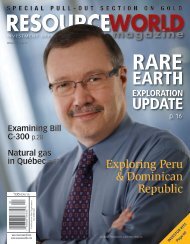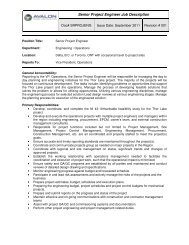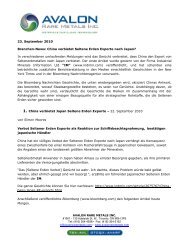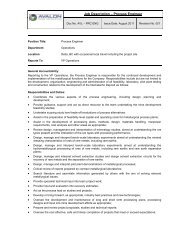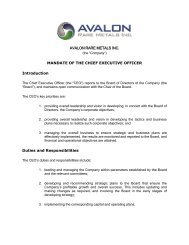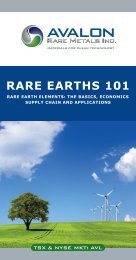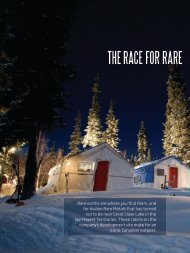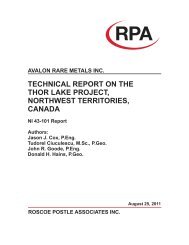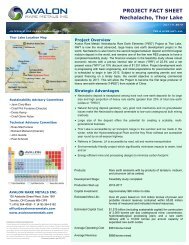technical report on the nechalacho deposit, thor lake project ...
technical report on the nechalacho deposit, thor lake project ...
technical report on the nechalacho deposit, thor lake project ...
Create successful ePaper yourself
Turn your PDF publications into a flip-book with our unique Google optimized e-Paper software.
Tb and Dy) were routinely m<strong>on</strong>itored al<strong>on</strong>g with <strong>the</strong> overall values for <strong>the</strong> total rare earths<br />
(TREE) and heavy rare earths (HREE).<br />
Precisi<strong>on</strong> results of <strong>the</strong> QAQC program for all labs, as measured by relative standard deviati<strong>on</strong><br />
(standard deviati<strong>on</strong>/sample populati<strong>on</strong> mean) for, as an example standard AVL-H (also referred<br />
to as STD-H), average between 3.5% and 5.7% for all rare earth elements, Nb, Ta and Zr. The<br />
results for <strong>the</strong> largest groups of analyses, representing 524 analyses of <strong>the</strong> standard, are listed<br />
in Table 14-2).<br />
Table 14-2 Relative Standard Deviati<strong>on</strong>s, Standard AVL-H (2007-2010)<br />
Samp_type Method Lab N Y %SD La %SD Ce %SD Pr %SD Nd%SD Sm %SD Eu %SD Gd %SD Tb %SD<br />
AVL-H MS81h ALS 224 3.6% 3.6% 3.6% 4.1% 3.8% 3.7% 3.8% 3.7% 4.6%<br />
STD-H 4A-4B Acme 89 7.1% 6.6% 7.1% 6.0% 5.4% 5.0% 6.0% 7.9% 6.2%<br />
STD-H MS81 ALS 112 5.1% 5.3% 4.9% 5.5% 5.7% 5.6% 5.2% 5.8% 5.8%<br />
STD-H MS81H ALS 99 3.7% 4.7% 4.6% 4.4% 4.1% 4.3% 4.1% 4.2% 4.8%<br />
Samp_type Method Lab N Dy %SD Ho %SD Er %SD Tm %SD Yb %SD Lu %SD Nb %SD Ta %SD Zr %SD<br />
AVL-H MS81h ALS 224 3.9% 4.6% 4.5% 4.4% 4.1% 4.8% 4.0% 4.2% 4.1%<br />
STD-H 4A-4B Acme 89 5.4% 6.3% 5.5% 6.1% 5.5% 6.3% 6.7% 7.5% 5.9%<br />
STD-H MS81 ALS 112 5.1% 5.7% 5.0% 5.6% 5.3% 5.4% 6.7% 7.4% 15.6%<br />
STD-H MS81H ALS 99 3.4% 4.1% 5.0% 4.5% 4.7% 4.4% 5.9% 5.5% 4.4%<br />
The results indicate that AVL-H/STD-H (same standard but inserted with different designati<strong>on</strong> in<br />
<strong>the</strong> drill logs) are basically identical in relative SD and that Acme’s analyses show about 50%<br />
higher relative standard deviati<strong>on</strong> than MS81H method of ALS. The latter laboratory’s MS81<br />
method shows slightly higher relative SD compared to MS81H. However, as <strong>the</strong> laboratories<br />
anticipate 10% relative standard deviati<strong>on</strong>, all are within acceptable limits.<br />
Thus it is c<strong>on</strong>cluded that <strong>the</strong> precisi<strong>on</strong> results of both laboratories are within acceptable limits for<br />
analyses from 2007 to 2010.<br />
Table 14-3 gives <strong>the</strong> calculated comparis<strong>on</strong> of <strong>the</strong> means of <strong>the</strong> particular set of analyses of<br />
STD-H expressed as percentage of <strong>the</strong> overall mean of all analyses of that standard from 2007-<br />
2010. The total analyses, including those in Round Robin campaigns and routine batches,<br />
include at least eight laboratories and methods for <strong>the</strong> rare earths. Comparis<strong>on</strong> of 112 analyses<br />
by MS81 (ALS), 323 analyses by MS81H (ALS) and 102 analyses by method 4A/B (Acme)<br />
indicate that <strong>the</strong> average differences are 101%, 99% and 95% respectively. Thus ALS results<br />
are very close to <strong>the</strong> mean of all labs, and Acme s<strong>on</strong> average about 5% lower than all<br />
laboratories.<br />
Technical Report 43-101 – March 13, 2011 Page 14-2<br />
Prepared by Aval<strong>on</strong> Rare Metals Inc.





